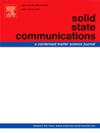The influence of the sintering temperature on optical, magnetic, thermal properties and charge density distribution of NiO ceramics
IF 2.1
4区 物理与天体物理
Q3 PHYSICS, CONDENSED MATTER
引用次数: 0
Abstract
This work describes the influence of sintering temperature (200 °C, 400 °C, and 1000 °C) on the structural, morphological, optical, and magnetic characteristics of nickel oxide (NiO) ceramics. Comprehensive characterization techniques such as powder X-ray diffraction (PXRD), UV–visible spectrometry, scanning electron microscopy (SEM), energy dispersive X-ray spectroscopy (EDS), vibrating sample magnetometry (VSM), and thermogravimetric analysis (TGA) to assess the sintering effects. PXRD analysis confirmed the formation of single-phase cubic NiO structure with the increase in peak intensities and average crystallite size 34 nm, 38 nm and 42 nm at 200 °C, 400 °C and 1000 °C signposted enhanced grain growth. Maximum Entropy Method (MEM) analysis revealed a covalent bonding of NiO ceramics. SEM and EDS analysis showed a well-defined and uniform distribution with elemental purity compositions Ni and O. Optical measurements signposted narrow band-gap energies 3.82 eV, 3.80 eV and 3.61 eV at increasing temperature. Additionally, magnetic characterization by VSM revealed a transition from weak to stronger ferromagnetism with increasing temperature. TGA/DTA demonstrated improved thermal stability in higher sintering temperature with weight loss of 7.58 %, 4.79 % and 3.37 % respectively. These findings accentuate the insights significant role in tailoring NiO ceramics for optoelectronics and nanotechnological applications.
烧结温度对NiO陶瓷的光学、磁性、热学性能和电荷密度分布的影响
这项工作描述了烧结温度(200°C, 400°C和1000°C)对氧化镍(NiO)陶瓷的结构,形态,光学和磁性的影响。综合表征技术,如粉末x射线衍射(PXRD),紫外可见光谱,扫描电子显微镜(SEM),能量色散x射线能谱(EDS),振动样品磁强计(VSM)和热重分析(TGA)来评估烧结效果。PXRD分析证实,在200°C、400°C和1000°C温度下,随着峰值强度和平均晶粒尺寸(34 nm、38 nm和42 nm)的增加,形成了单相立方NiO结构,晶粒生长加快。最大熵法(MEM)分析发现NiO陶瓷存在共价键。SEM和EDS分析表明,Ni和o的元素纯度分布均匀,随温度升高,其能带能分别为3.82 eV、3.80 eV和3.61 eV。此外,VSM的磁性表征表明,随着温度的升高,铁磁性由弱向强转变。在较高的烧结温度下,TGA/DTA表现出较好的热稳定性,失重率分别为7.58%、4.79%和3.37%。这些发现强调了在光电子和纳米技术应用中定制NiO陶瓷的重要作用。
本文章由计算机程序翻译,如有差异,请以英文原文为准。
求助全文
约1分钟内获得全文
求助全文
来源期刊

Solid State Communications
物理-物理:凝聚态物理
CiteScore
3.40
自引率
4.80%
发文量
287
审稿时长
51 days
期刊介绍:
Solid State Communications is an international medium for the publication of short communications and original research articles on significant developments in condensed matter science, giving scientists immediate access to important, recently completed work. The journal publishes original experimental and theoretical research on the physical and chemical properties of solids and other condensed systems and also on their preparation. The submission of manuscripts reporting research on the basic physics of materials science and devices, as well as of state-of-the-art microstructures and nanostructures, is encouraged.
A coherent quantitative treatment emphasizing new physics is expected rather than a simple accumulation of experimental data. Consistent with these aims, the short communications should be kept concise and short, usually not longer than six printed pages. The number of figures and tables should also be kept to a minimum. Solid State Communications now also welcomes original research articles without length restrictions.
The Fast-Track section of Solid State Communications is the venue for very rapid publication of short communications on significant developments in condensed matter science. The goal is to offer the broad condensed matter community quick and immediate access to publish recently completed papers in research areas that are rapidly evolving and in which there are developments with great potential impact.
 求助内容:
求助内容: 应助结果提醒方式:
应助结果提醒方式:


